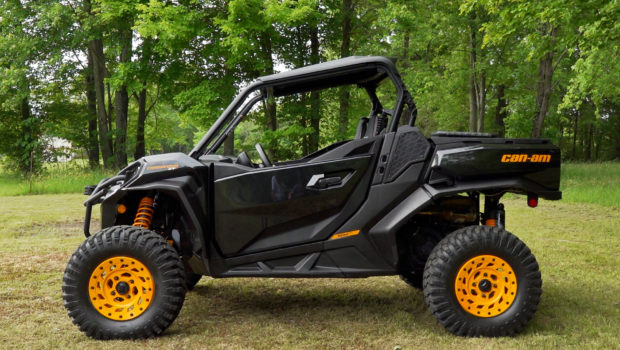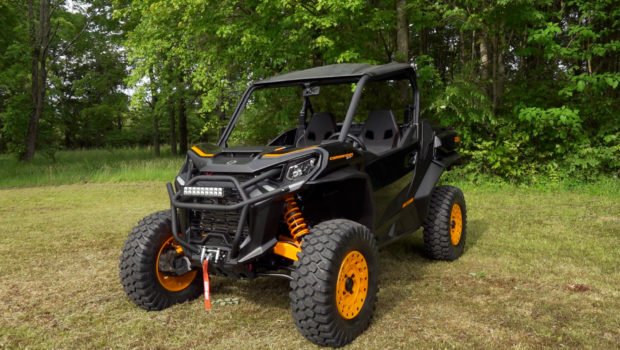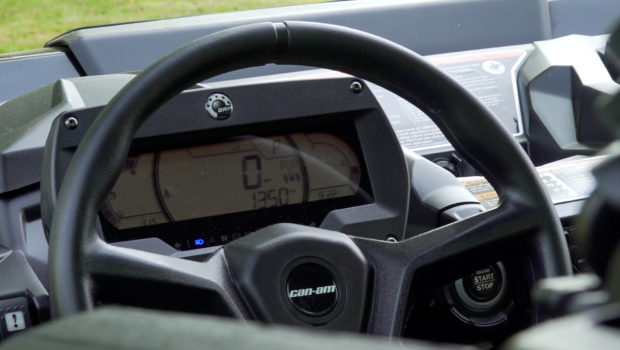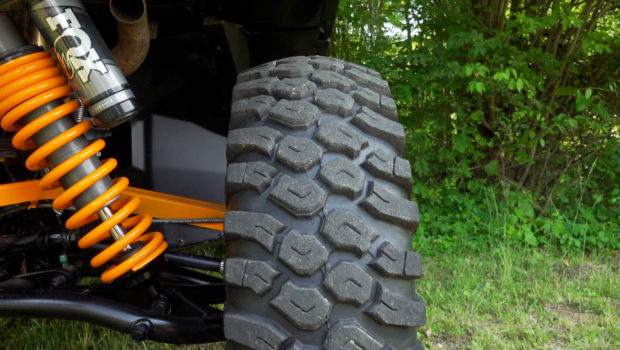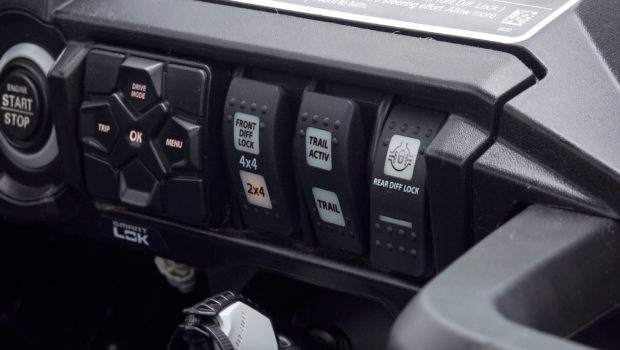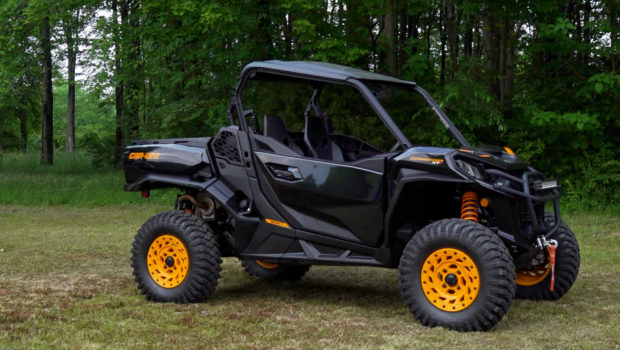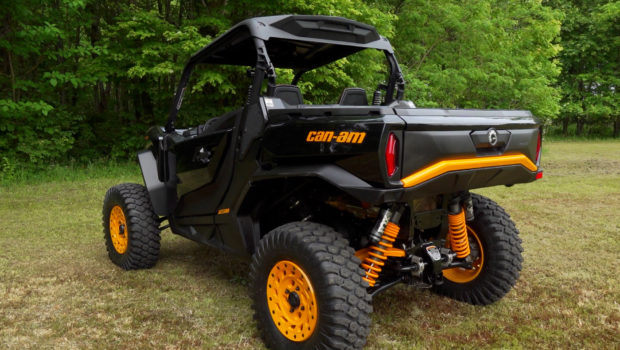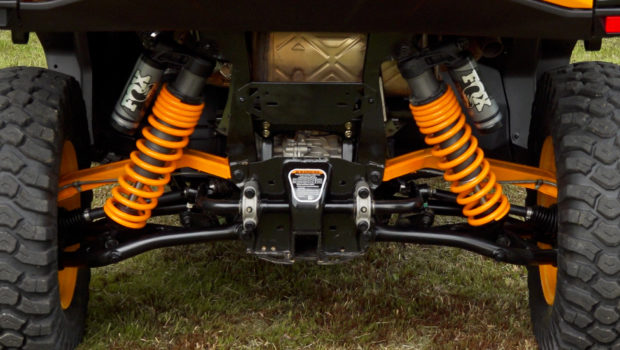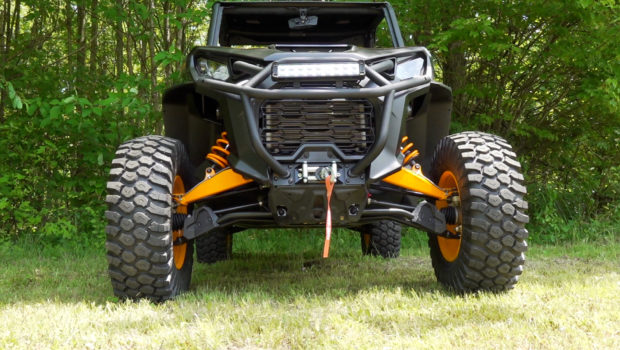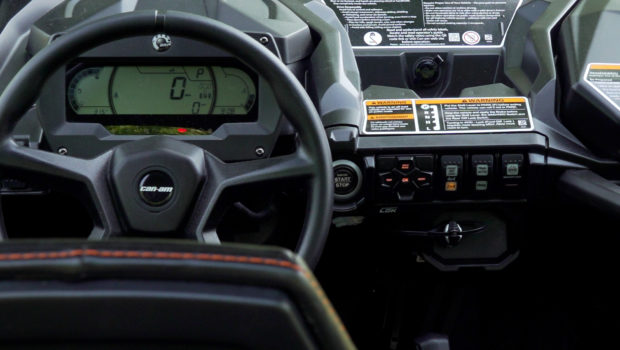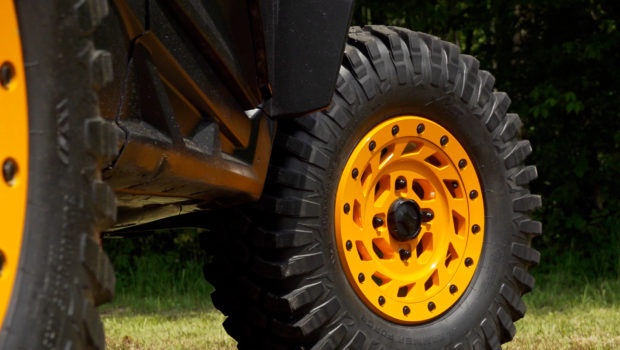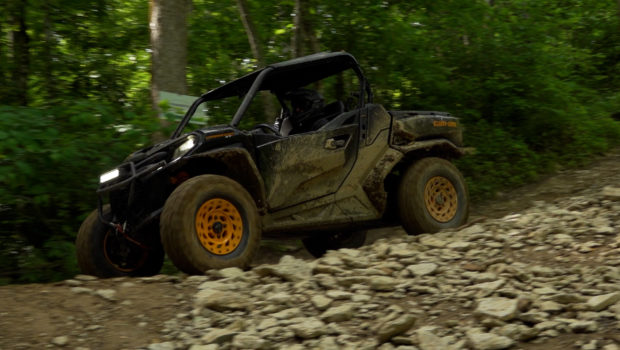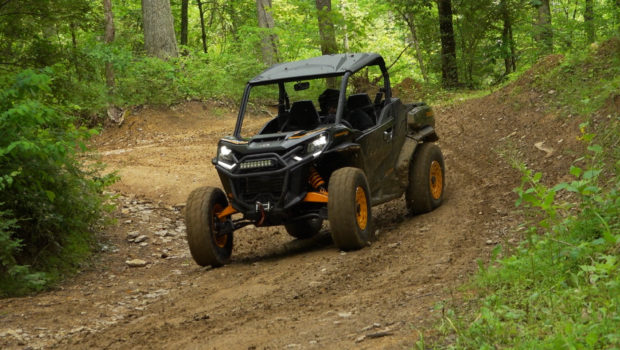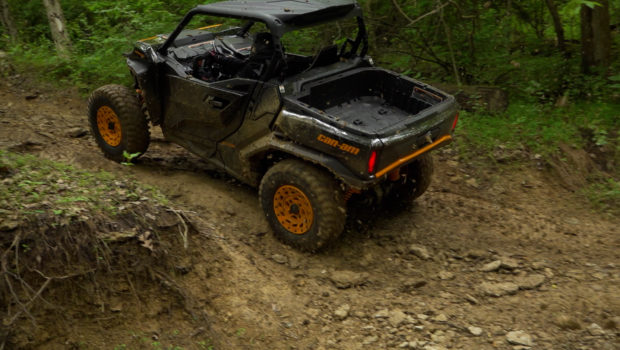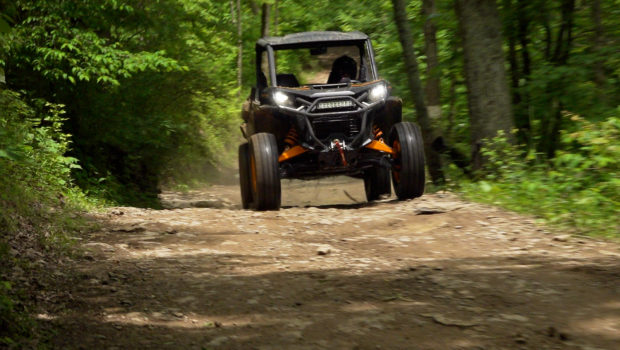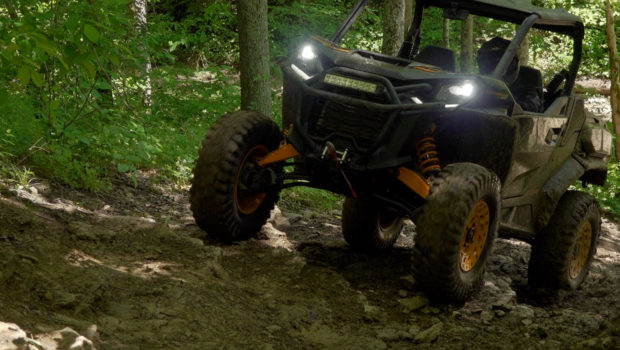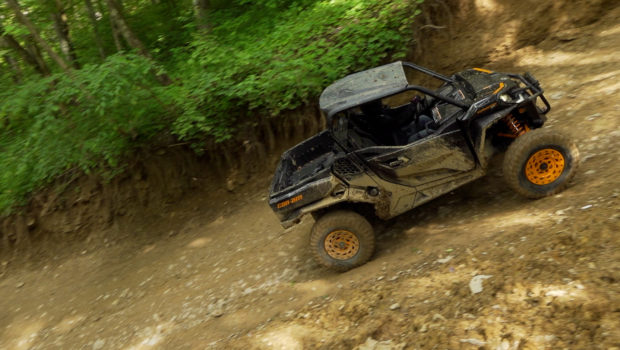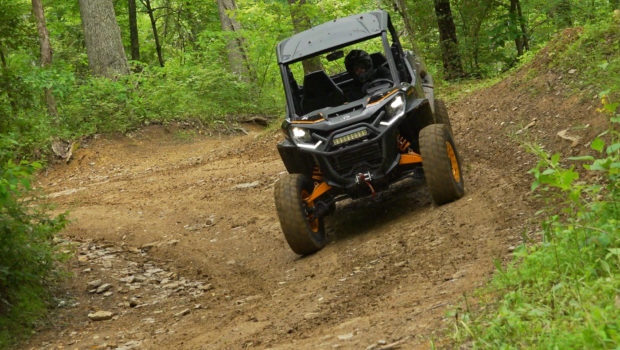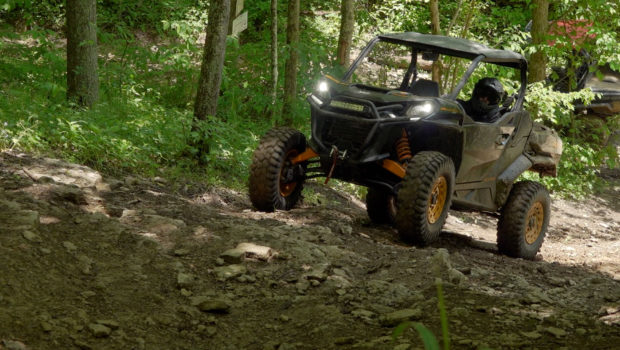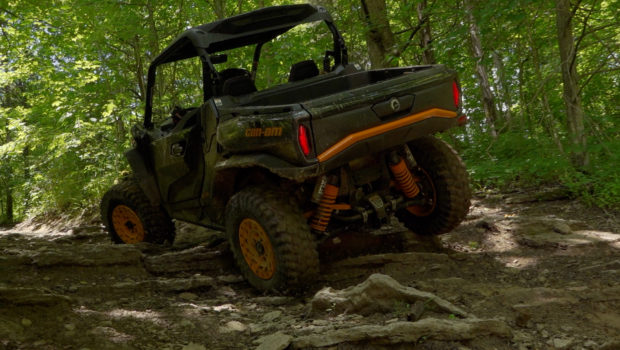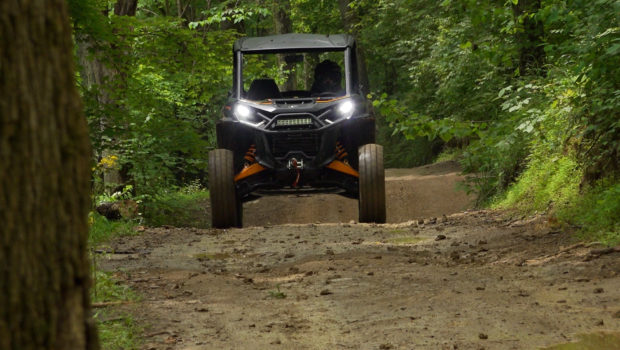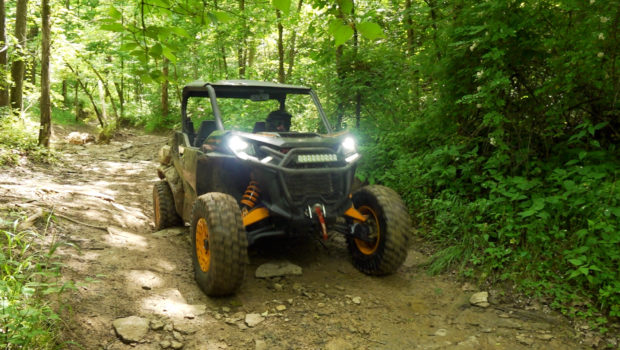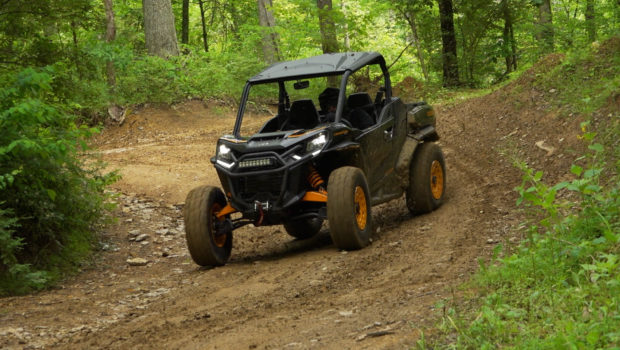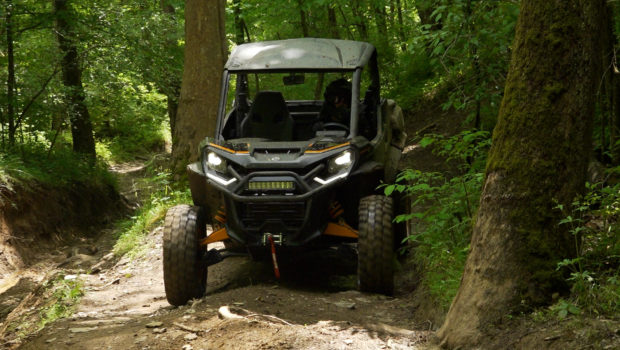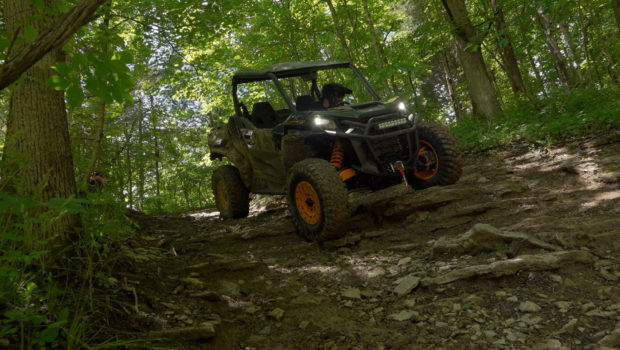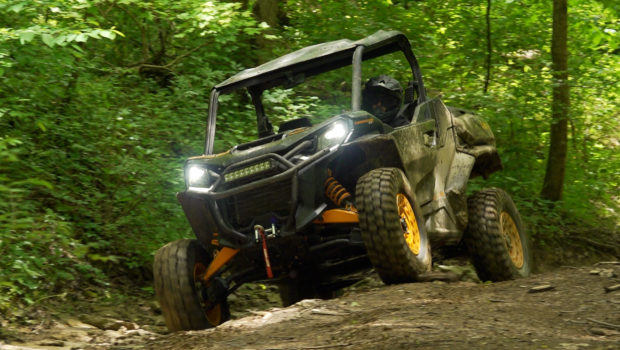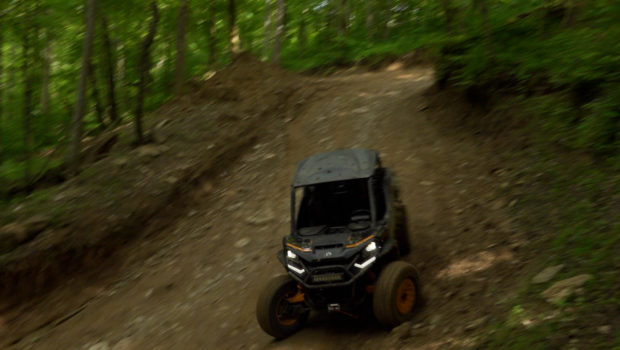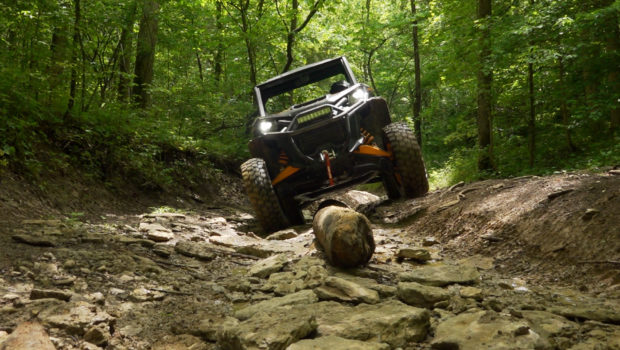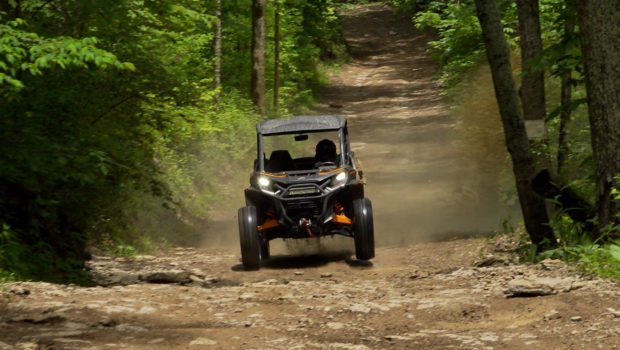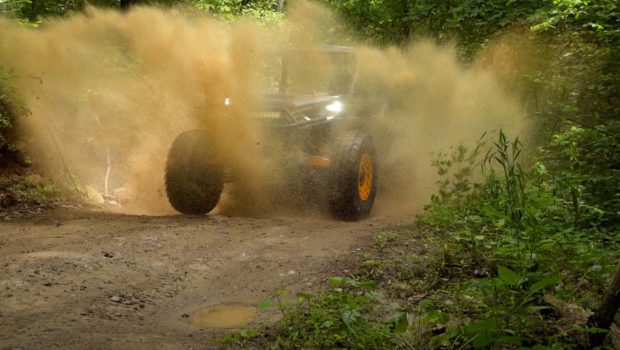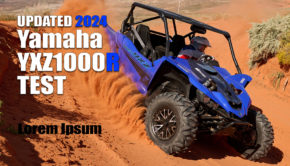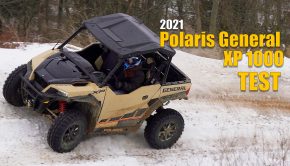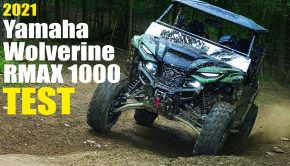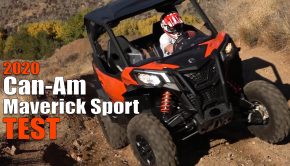Published on August 9th, 2021 | by Joe
2021 Can-Am Commander 1000R XT-P Test Review
When Can-Am released the 2010 Commander 1000, they carved out a niche in the SXS market with a machine that could play as hard as it worked; a quiver killer in its day for those who could own only one machine, but wanted to do it all. Can-Am enjoyed their spot at the top of the sport/utility segment for six years until the arrival of the Polaris General in 2016. The arrival of the Yamaha RMAX in 2021 further diminished the appeal of the Commander in a segment it once dominated.
Things changed in the mid 2021 model year, though, as Can-Am introduced an entirely new line of Commander models with two and four-seat MAX options available. Not entirely new machines from the ground up, the new Commanders are essentially the proven and fun to drive Maverick Sport models adapted for getting work done through the addition of a dumping cargo bed plus other small tweaks to the engine, chassis, and suspension.
For our test of the 2021 Can-Am Commander 1000R, we opted to go with their top-of-the-line XT-P model. Why not? The Commander XT-P is $300 less in price than the mid-level Yamaha RMAX2 1000 and $1,300 less than the base model, Polaris General Deluxe. This will let us experience the best that the new Commander has to offer while setting us up for a competitively priced three-way shootout in the 1000cc sport utility class so you might want to subscribe.
Trim Packages
Sharing the same 1000 class Rotax Engine, plus many of the same premium features and benefits, Can-Am is offering three trim packages: DPS, XT, and XT-P. Starting at $16,399, the DPS model is slightly narrower than the others at 62” wide. Its width is achieved by using control arms from the 60” wide Maverick sport with +1” offset, 14” steel wheels wrapped in 27” XPS Trail Force tires yielding 12.5” of ground clearance. It features 12.5” and 13” of suspension travel front and rear.
The Commander XT and XT-P models measure in at 64” wide using arched control arms borrowed from the 64” wide Maverick Sport X XC. Starting at $18,999, the Commander XT makes the switch to 1” taller, 28” XPS Trail King Tires mounted on 14” cast aluminum wheels, boosting ground clearance to 13”. The wider XT delivers 15” of suspension travel at both ends. Other key upgrades shared with the XT-P include a heavy duty front bumper, 4,500 LB winch, 7.8” digital instrument display, LED signature lights, and a sport roof. It’s similarly appointed to the Yamaha and Polaris 64” entry level models for $1,000-$1,500 less.
Starting at $22,199, the XT-P offers the most sport focused features for the money in the Sport Utility segment. The XT-P makes the switch from Can-Am’s hydraulic pressure activated, Visco-Lok, auto-locking front differential to their computer controlled, Smart-Lok system, offering the ability to fully lock the front differential at the flip of a switch. Unlike the other Commanders, the XT-P runs a square tire setup with the same size 30×10-15” XPS Hammer Force tires used at all four corners, mounted on 15” aluminum beadlock wheels. With a 2” taller tire than the XT model, suspension travel needed to be reduced by 1” all around to 14” at all four corners to protect the underside of the fenders. This was accompanied with an upgrade from twin-tube shocks to premium Fox 2.5 Podium QSE shocks. A panoramic rear view mirror rounds out the package.
Testing Location
After a few hours of rain the day before creating slick trail conditions, we loaded up and headed down to 250 acre Dirty Turtle Off-Road Park, located in Bedford, Ky. They’ve got trails for most skill levels, a short course race track, climate controlled cabins plus more, offering more amenities per acre than most ride parks we’ve visited.
Engine
The Commander’s engine, transmission, and drivetrain are packed full of the latest technology in the segment along with the most versatile drivetrain in the industry. Sharing its 976cc V-twin, liquid-cooled, fuel-injected engine with the Maverick Sport. It produces 100 HP and 76 FT-LB of torque. It’s tuned for smoother power delivery and lower RPM operation thanks to different levers, ramp, and weights in the CVT’s clutch. Can-Am’s Quick Response CVT features Dual forward ranges plus neutral, reverse, and park are selected by a gated shifter.
Electronic Belt Protection protects the belt from damage by noobs. It cuts power and sends a message to the display letting you know to shift to low range when the vehicle senses high RPMs and low speed, like when climbing slowly or pulling a heavy load in high range. Electronic Hill Descent Control provides engine braking. Ventilation for the engine and transmission are mounted high on the sides behind the doors with dual inlets for the CVT for added cooling.
After installing Can-Am’s DESS Key, the Commander fires up and shuts down with the push of a button. Warm-up tire is minimal with zero cold stalls to report. Pushing around an added 321 LBS and 3” taller tires than the Maverick Sport, the Commander utilizes quick clutch engagement off idle, making it easy to get moving pretty quickly. With smooth, manageable low-end power, the Commander feels well-mannered on the trail or job site. Power builds seamlessly into the midrange where the Rotax engine does its best work. Acceleration is on the sporty side, with enough get up and go for hauling big loads, tackling most climbs or breaking the back end loose for slides in wet or dry conditions.
Compared to the Maverick Sport, the Commander’s revised clutching seems to keep the engine running on the torque curve as opposed to keeping it pegged at peak horsepower, making the Commander seem like more of a torque machine than a revver. This makes power delivery a little tamer, while keeping decibels down inside the cabin and alongside the trail. Lower RPM operation should certainly save on fuel as well.
We feel the clutching is well calibrated for a balance of sport riding, long cruises, and getting work done. If you’d prefer the slightly harder hitting, higher revving power delivery of the Maverick Sport, a good clutch kit should be all that’s necessary to add it back. We’d expect companies like Dalton Industries to have kits already in the works, and we had tremendous success with one of their kits for 30” tires on a Maverick Sport.
Low range works great for towing or crawling with a top speed or 28 MPH. High range is said to top out at 71 MPH. When the trail turns downhill, low-range offers a higher level of engine braking, ideal when you’re loaded down, or you simply want to reduce wear on the brakes. Engine braking in high range is smooth and effective without interfering with sporty driving.
Can-Am’s Intelligent Throttle Control offers two modes: Sport mode for typical or spirited driving and ECO mode, designed to save fuel and filter out unwanted gas pedal inputs while reducing torque output by around 20%. ECO mode works best maneuvering in tight confines or when traction is at its worst and difficult to maintain. We enjoyed the benefits of it, but Can-Am seemed to have the gas pedal design nailed making it easy to modulate without the need for electronic trickery like some.
Can-Am has taken drivetrain performance and versatility to the next level on the Commander XT-P. The computer-controlled Smart-Lok front differential offers three modes to choose from: Trail, which performs very similarly to Can-Am’s hydraulically-controlled Visco-Lok differential, reacting to front wheel slippage by locking in the front differential. Trail-Active looks at vehicle speed, throttle, steering, and other factors working to predict the need for added traction in an effort to lock in the front differential before either front wheel brakes traction. Both Trail and Trail-Active automatically unlock the front differential when you let off the throttle. The biggest benefit of the Smart-Lok system is the addition of true front differential lock, which you can engage and disengage with the push of a button. One of the coolest options we’ve discovered with the new Smart-Lok system is that you can use any of the front drive options with or without the rear differential locked. This makes for a great way to increase traction with the rear differential unlocked increasing without causing added damage to the ground in sensitive areas. It’s brilliant and no one else offers it.
Slick trails and tires best suited for dry or rocky conditions kept us testing all flavors of Smart-Lok throughout the day. Driving into and out of slick turns, we noticed a bit of front end push unless we got one of the front wheels spinning enough to lock in the front differential. Trail Active made a noticeable difference in this situation. You could tell that the front differential was locking in much more proactively due to the fact that the front end was predictably going where it was pointed, allowing us to drive much harder into turns.
We did find the limits of Trail and Trail-Active modes on a muddy hill littered with small rock ledges. We simply couldn’t crawl up without one-wheel spin from the front end deflecting the Commander offline. Locking in the front differential was an instant game changer allowing the Commander to reach the top holding a line without issue.
Overall, Engine performance encourages you to drive all day long and its Swiss Army Pocket Knife drivetrain is prepared for anything you encounter along the way.
Chassis and Suspension
The Maverick Sport’s DP980 and HSLA steel chassis was adapted and reinforced for the addition of the Commander’s dump bed and a few other small changes. Other than that, it’s the same great handling chassis down to the shock mounting points and the plastic skid plate protecting the chassis. The DP980 reinforced steel cage is designed to be strong and light adding to the overall rigidity of the chassis. The front bumper offers more coverage than the competition. It’s built to take a beating and features integrated light bar mounts.
Maverick Sport XX C arched dual front A-Arms and arched Torsional Trailing Arms used on the Commander XT-P look well-crafted and built to take a beating. They’re paired with Fox 2.5 Podium QS3 shocks controlling 14” of travel at both ends. They feature threaded spring preload and three-way compression damping adjustment with soft, medium and firm settings. Sway bars are used at both ends and single-mode, electronic Dynamic Power Steering is equipped.
At a standard 64” wide, the Commander’s 90.6” wheelbase is the longest in the class at 7.6 longer than the shortest car in the class, the General XP 1000. Rolling on 30×10-15” XPS Hammer Force Tires mounted on 15” cast-aluminum beadlock wheels at all four corners, the Commander XT-P delivers the race ready wheel setup we prefer on all our recreational SXS. 13.5” of ground clearance is right in line with the class.
Suspension performance is very good for a machine with serious work capability built in. The shocks react well to small bumps smoothing out the trail without leaving you feeling completely disconnected from it. The shocks gobble up roots and small rocks and hold up well to smooth G-outs and small rollers in the trail at a respectable pace. The long wheelbase adds to the stability in the rough stuff while reducing the feeling of bumps being transferred to the occupants. It’s very noticeable inside the cockpit.
Like others in the class, if you get too carried away, you’ll find the limits of the front shocks on square edged G-outs and the rear end doesn’t hold up to whooped out or choppy terrain quite as well as the Maverick Sport. Increasing spring preload and/or flipping Compression damping to firm at both ends helps some when you’re pushing the limits, but we liked the feeling of the Commander on full soft floating over most of what the trail threw at us while slowing down a little bit in the roughest sections then getting right back on the gas.
Cornering stability could easily be best in class. The Commander corners flat, and it feels that way when you drive it. That good stability is also appreciated on uneven or off camber trails. It doesn’t have the level of articulation for extremely uneven or chunky terrain as the Yamaha RMAX, but its long wheelbase, lack of body roll, and predictable feeling keep you moving forward with confidence. The long wheelbase helps keep things planted on steep climbs and descents. With 13.5” of ground clearance, the longer wheelbase didn’t result in many notable frame outs during our testing, and the Commander has an impressive ability to deal with tight turns, right up to the point where you have to turn around in the middle of the trail where the longer wheelbase might put a couple more points on the turn.
As we mentioned earlier, using Trail Active mode on the Smart-Lok front differential provided pretty accurate steering for trail cruising and sporty driving even though the stock tire setup wasn’t ideal for our wet testing conditions. Although we can attest from other testing we’ve done with a set of terrain appropriate Super Grip K9 tires recommended to us by Planet SXS, the Commander is an impressively accurate steering machine even without employing all of the wizardry the Smart-Lok system provides. This is great news if you’re considering the XT or DPS models.
Power steering performance is good, although some drivers have said it’s a bit too light at lower speeds on slick terrain, while others feel its assist falls off a little more than they’d like with more aggressive tires in high traction conditions while cornering at high speed regardless of drive train mode. With no consistent criticism, we chalk it up to individual driver preference with power steering doing its job pretty well.
Overall, handling and suspension are stable, plush, predictable and impressive.
Brakes
The Maverick Sport’s brakes stop the Commander. They feature 220mm rotors and dual piston calipers at all four corners. Braking power is good, although it didn’t feel quite as impressive as we remember the Maverick Sport, most likely due to the larger tires, wheels, and heavier overall weight. Still, there’s enough stopping power for charging corners or keeping a heavy load under control on downhills.
Utility Capability
In its class, the Commander is arguably best equipped when it comes to getting work done. Its hydraulically assisted tilting cargo bed shares a 600 LB rating with its rivals but offers the largest bed dimensions of the bunch. It features four tie down anchors, 8 LinQ anchor points for easy integration with Can-Am extensive line of accessories, and the bed features channels for easy partitioning with plywood. Can-Am also wisely located the beds release levers above the fender flares helping protect them and your hands from mud. The bed sides can be easily removed providing access to additional storage. A great place to keep a spare belt, tow rope, or other items.
A 2” hitch receiver lets you share your hitch with your truck and is rated to tow 2,000 pounds, equaled only by the Yamaha RMAX. A 4,500 LB winch takes care of another major need for work or trail riding applications.
Interior and other Details
The Commander is the only machine in its class that feels like a sport SXS when you strap it on. It’s virtually identical to the Mav Sport’s interior down to its high-quality half doors, which are curved outward for added shoulder room. They open with strong, rigid feeling levers inside and out. Rubber sealed, they close tightly with no detectable rattling on our unit. The seats are the only ones in the class with pass through for four-point harnesses, a must have accessory for serious sport driving. The driver’s seat can be slid 5” front to back. The steering wheel has 25° of tilt adjustment. A non-adjustable grab handle is available on the passenger’s side. It’s well placed and does its job, but rarely feels necessary in the Commander.
Getting in and out, the higher floor side and lower seats make sliding in and out to take a bit more effort than the other sport/utility machines. Most riders under 6’3” can fit comfortably inside the Commander. While the doors add shoulder room, the occupants sit a bit closer inside the Commander, although contact shouldn’t be a problem. The seats feel lower and more reclined than the others in the class. The lower seating position works beautifully with the longer wheelbase and plush suspension better isolating you from the chaos going on at either end of the machine. The feeling of bumps, pitching, and rolling are all reduced making the Commander a machine you’ll appreciate more the longer the ride goes. It also provides a better feeling for what the machine is doing, a big benefit when pushing the limits of traction, stability, or both.
A sizable, 7.6” all-digital display tilts with the steering wheel providing easy viewing. The fancy drivetrain, throttle modes, push button this and that result in a bush dash with little room leftover to add switches for accessories. An impressive 5.3 gallons of storage are available in its two dash-mounted storage boxes. There’s a small tray center dash with a DC power outlet and another smaller one at the front of the center console. A rubber flanged cup holder is available on the floor on either side of the machine in front of the sets.
The low seats and higher line of the hood and cargo box make judging what’s right in front of or behind the Commander more difficult. Fender flares at all four corners do well at keeping you protected from flying debris. Interior noise is pretty low keeping stress down and conversation easy.
Can-Am’s signature LED running lights make you visible during the day, while low and high beam LED headlights light up the trail at night. LED tail and brake lights are used out back.
Maintenance
Requiring maintenance at 1,000 and 3,000 mile intervals, the Commander has a less demanding maintenance compared to its competitors. As a machine we’d plan on keeping a long time after the warranty runs out, we’d do a couple of added oil changes in the first 1,000 miles and check the filter after every ride to make sure the motor stays clean inside. Gone are the nightmare days of maintenance and belt changes on Can-Am SXS with no tools filter access, a CVT belt that can be changed out quickly, a radiator cover that can be removed with two clips for easy cleaning plus many more maintenance access points well thought for easy do-it-yourself maintenance.
Conclusion
As usual, Can-Am’s XT-P package delivers a great balance of added style, sport performance, and utility functionality. Yes, it lacks the GPS of the Yamaha and the interior LED interior lights of the competition. However, the XT-P delivers the strength and survivability of beadlock wheels, a bumper that we can attest can take a real beating, along with the most sophisticated arguably functional drivetrain on the market. All are reasons that we feel the Commander XT-P offers pretty exceptional value in its class.
Sure, the Commander will work fine around your smaller local ride parks and for chores around the house, but it begs for big adventures. Load it down with gear for a weekend of camping and trail riding, or use it for the ultimate destination machine. The Commander offers all the room needed to bring along most anything you’ll need. Its performance allows you to cover plenty of miles in a day and its comfortable sport SXS cockpit, predictable handling, and plush suspension leaves you feeling ready for more. If you are looking for a good sport/utility SXS and you enjoy big rides, we believe the brand new Can-Am Commander 1000R XT-P is a SXS that you’ll

